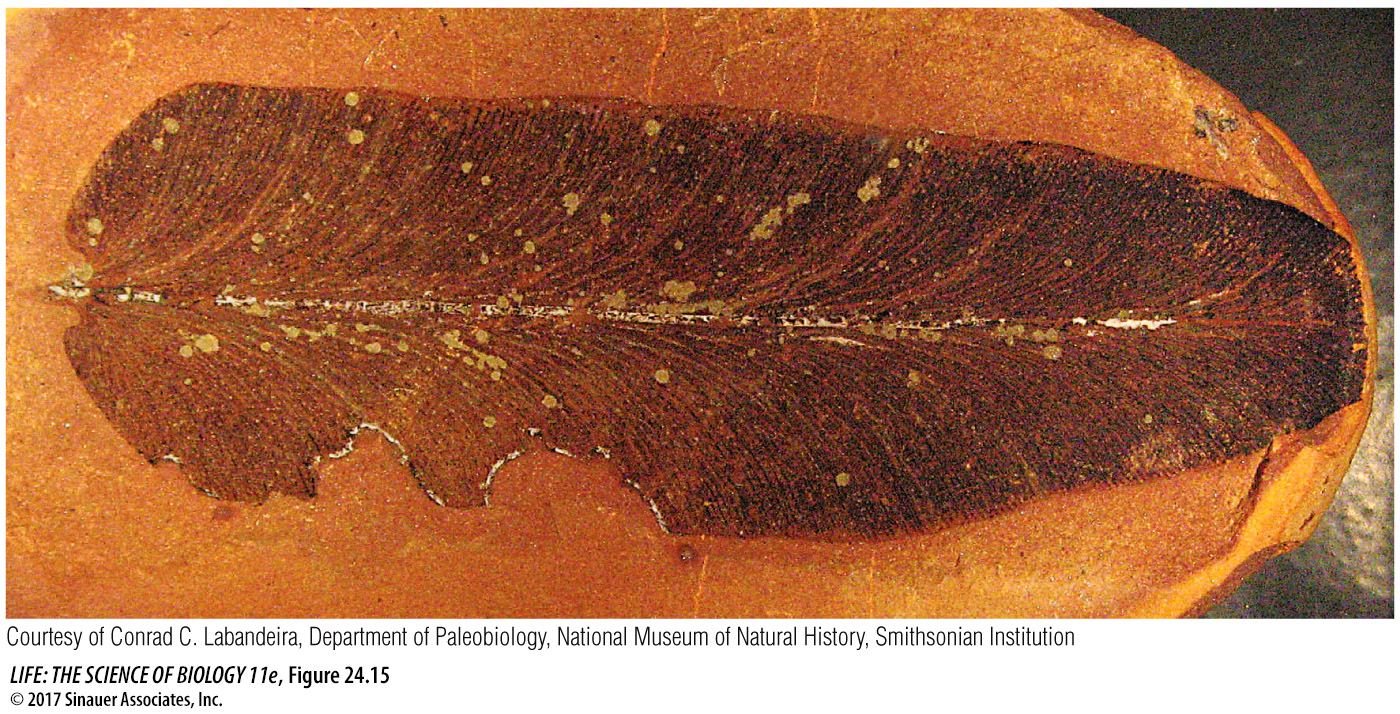Many groups of organisms that arose during the Cambrian later diversified
Geologists divide the remainder of the Paleozoic era into the Ordovician, Silurian, Devonian, Carboniferous, and Permian periods. Each period is characterized by the diversification of specific groups of organisms. Mass extinctions marked the ends of the Ordovician, Devonian, and Permian.
THE ORDOVICIAN (488–444 MYA) During the Ordovician period, the continents, which were located primarily in the Southern Hemisphere, still lacked multicellular life. Evolutionary radiation of marine organisms was spectacular during the early Ordovician, especially among animals, such as brachiopods and mollusks, that lived on the seafloor and filtered small prey from the water. At the end of the Ordovician, as massive glaciers formed over the southern continents, sea levels dropped about 50 meters, and ocean temperatures dropped. About 75 percent of all animal species became extinct, probably because of these major environmental changes.
THE SILURIAN (444–416 MYA) During the Silurian period, the continents began to merge together. Marine life rebounded from the mass extinction at the end of the Ordovician. Animals able to swim in open water and feed above the ocean floor appeared for the first time. Jawless fishes diversified, and the first fishes with supporting rays in their fins appeared. The tropical sea was uninterrupted by land barriers, and most marine organisms were widely distributed. On land, the first vascular plants evolved late in the Silurian (about 420 mya). The first terrestrial arthropods—scorpions and millipedes—evolved at about the same time.
THE DEVONIAN (416–359 MYA) Rates of evolutionary change accelerated in many groups of organisms during the Devonian period. The major land masses continued to move slowly toward each other. In the oceans there were great evolutionary radiations of corals and of shelled, squidlike cephalopod mollusks. Fishes diversified as jawed forms replaced jawless ones and as bony armor gave way to the less rigid scales of modern fishes.
Terrestrial communities changed dramatically during the Devonian. Club mosses, horsetails, and tree ferns became common, and some attained the size of large trees. Their roots accelerated the weathering of rocks, resulting in the development of the first forest soils. The first plants to produce seeds appeared in the Devonian. The earliest fossil centipedes, spiders, mites, and insects date to this period, as do the earliest terrestrial vertebrates.
A massive extinction of about 75 percent of all marine species marked the end of the Devonian. Paleontologists are uncertain about its cause, but two large meteorites that collided with Earth at about that time (one in present-day Nevada, the other in Western Australia) may have been responsible, or at least a contributing factor. The continued merging of the continents, with the corresponding reduction in the area of continental shelves, may have also contributed to this mass extinction.
THE CARBONIFEROUS (359–299 MYA) Large glaciers formed over high-latitude portions of the southern land masses during the Carboniferous period, but extensive swamp forests grew on the tropical continents. These forests were dominated by giant tree ferns and horsetails with small leaves. Their fossilized remains formed the coal we now mine for energy. In the seas, crinoids (a group of echinoderms, related to sea stars and sea urchins) reached their greatest diversity, forming “meadows” on the seafloor.
The diversity of terrestrial animals increased greatly during the Carboniferous. Snails, scorpions, centipedes, and insects were abundant and diverse. Insects evolved wings, becoming the first animals to fly. Flight gave herbivorous insects easy access to tall plants, and plant fossils from this period show evidence of chewing by insects (Figure 24.15). The terrestrial vertebrates split into two lineages. The amphibians became larger and better adapted to terrestrial existence, while the sister lineage led to the amniotes: vertebrates with well-protected eggs that can be laid in dry places.

Figure 24.15 Evidence of Insect Diversification The margins of this fossil fern leaf from the Carboniferous have been chewed by insects.
Page 521
Page 522
Page 523
Page 524
THE PERMIAN (299–251 MYA) During the Permian period, the continents merged into a single supercontinent called Pangaea. Permian rocks contain representatives of many of the major groups of insects we know today. By the end of the period the amniotes had split into two lineages: the reptiles, and a second lineage that would lead to the mammals. Ray-finned fishes became common in the freshwaters of Pangaea.
Toward the end of the Permian, conditions for life deteriorated. Massive volcanic eruptions resulted in outpourings of lava that covered large areas of Earth. The ash and gases produced by the volcanoes blocked sunlight and cooled the climate. The death and decay of the massive Permian forests rapidly used up atmospheric oxygen, and the loss of photosynthetic organisms meant that relatively little new atmospheric oxygen was produced. In addition, much of Pangaea was located close to the South Pole by the end of the Permian. All of these factors combined to produce the most extensive continental glaciers since the “snowball Earth” times of the late Proterozoic. Atmospheric oxygen concentrations gradually dropped from about 30 percent to 15 percent. At such low concentrations, most animals would have been unable to survive at elevations above 500 meters, so about half of the land area would have been uninhabitable at the end of the Permian. The combination of these changes resulted in the most drastic mass extinction in Earth’s history. Scientists estimate that about 96 percent of all multicellular species became extinct at the end of the Permian.
